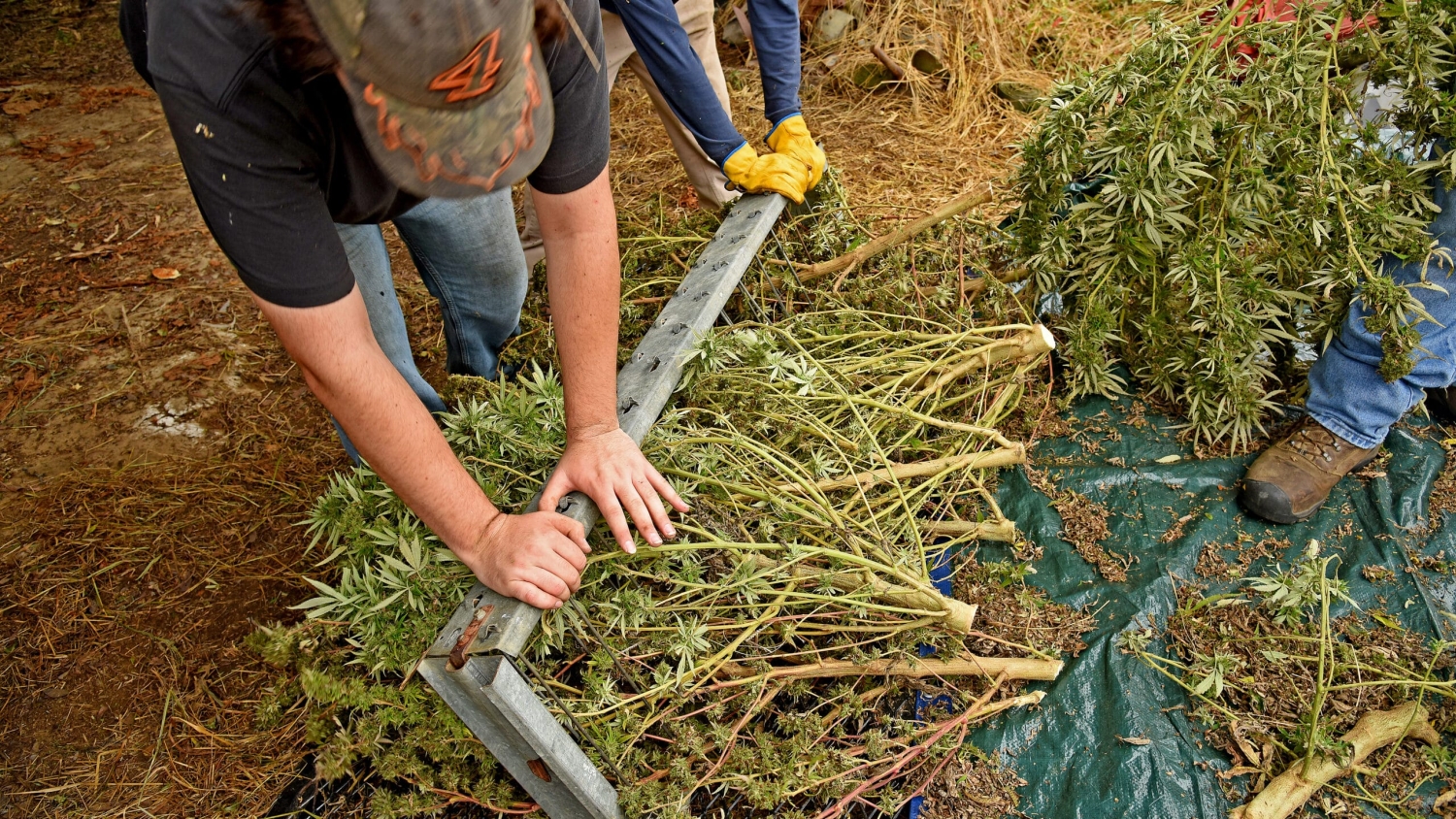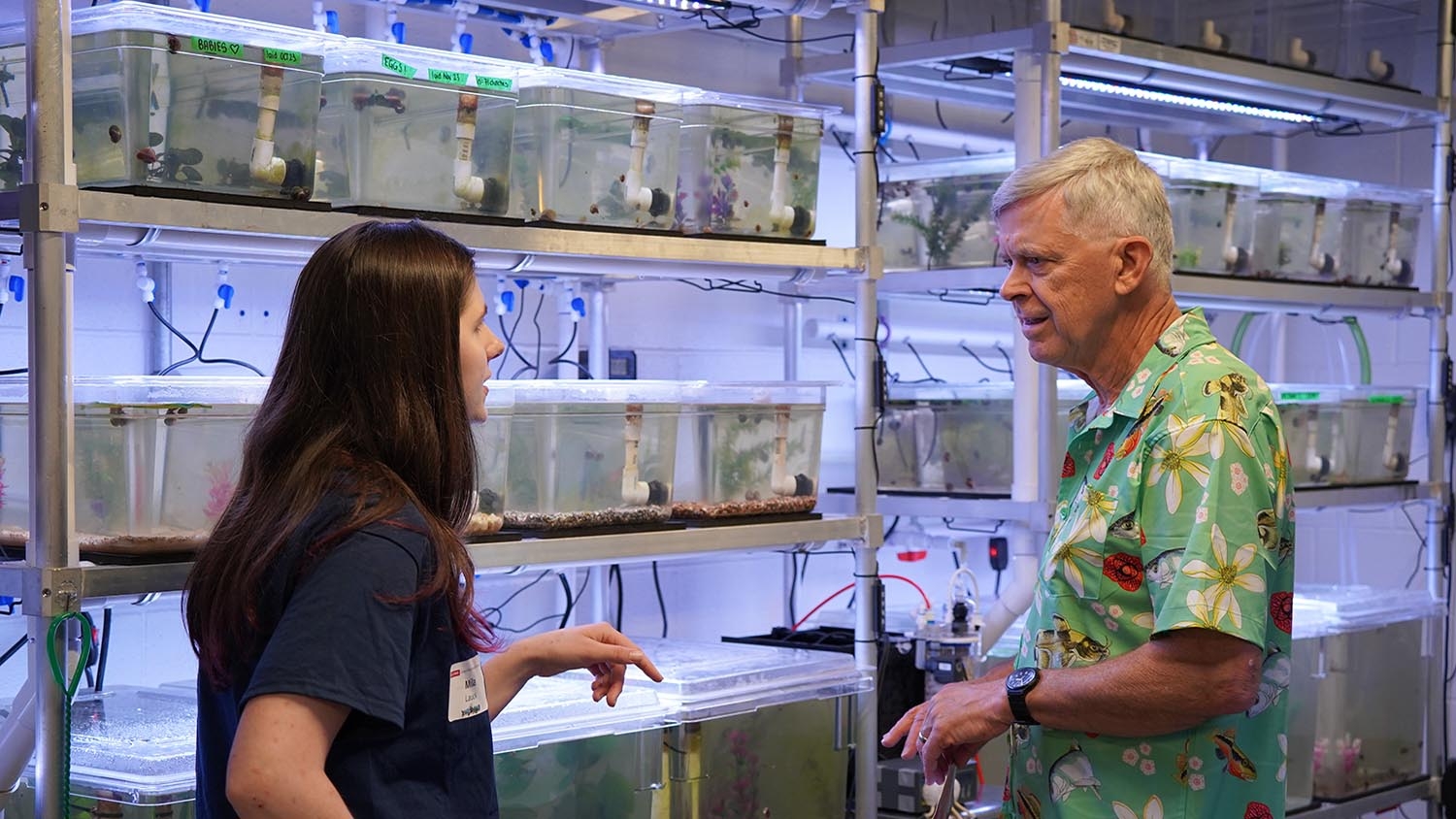Lizards, Convergent Evolution and Life After Humans, an Interview with Jonathan Losos
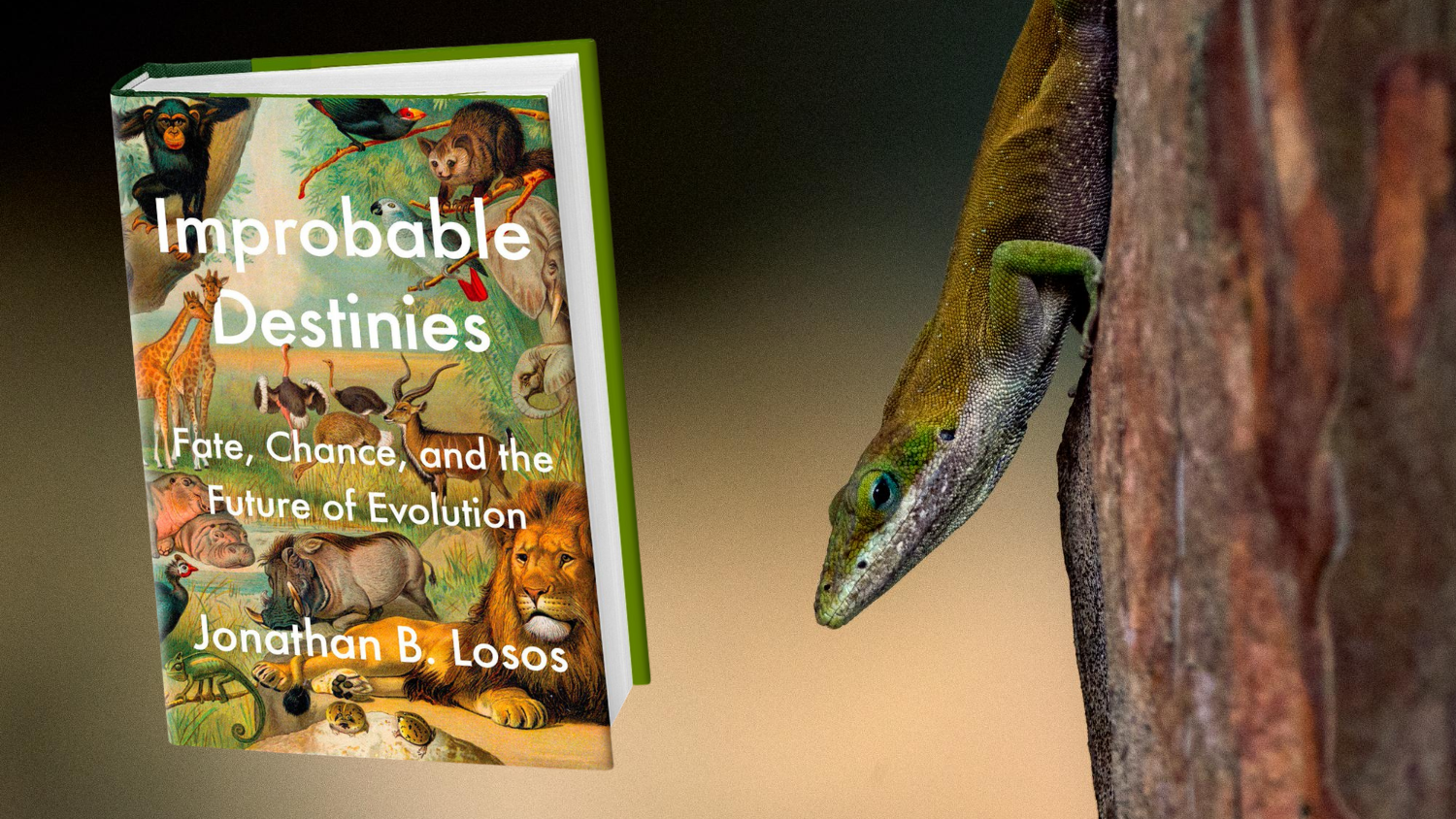
 Jonathan Losos is a William H. Danforth Distinguished University Professor at Washington University in St. Louis. He is now Director of the Living Earth Collective, a research hub focused on our greatest challenge – sustaining life on Earth. Losos is a renowned evolutionary biologist, perhaps best known for a series of ground-breaking studies in which he documented that in the carribean Anolis lizards, upon colonizing islands, have repeatedly evolved a series of morphotypes. These morphotypes correspond to the basic way an anole can take advantage of the caribbean environment. Most islands have, for example, a species of Anole with the “Crown Giant” morphotype. But the “Crown Giants” on different islands are not most closely related to each other. They are instead most closely related to other species on the same island. Given similar circumstances, the evolutionary trajectory of anoles repeats and, at least in the Caribbean, is predictable and convergent. This work on anoles, along with related research on stickleback fish, led Losos to think about and write about such convergence in the big story of life more generally in his latest book, Improbable Destinies: Fate, Chance, and the Future of Evolution.
Jonathan Losos is a William H. Danforth Distinguished University Professor at Washington University in St. Louis. He is now Director of the Living Earth Collective, a research hub focused on our greatest challenge – sustaining life on Earth. Losos is a renowned evolutionary biologist, perhaps best known for a series of ground-breaking studies in which he documented that in the carribean Anolis lizards, upon colonizing islands, have repeatedly evolved a series of morphotypes. These morphotypes correspond to the basic way an anole can take advantage of the caribbean environment. Most islands have, for example, a species of Anole with the “Crown Giant” morphotype. But the “Crown Giants” on different islands are not most closely related to each other. They are instead most closely related to other species on the same island. Given similar circumstances, the evolutionary trajectory of anoles repeats and, at least in the Caribbean, is predictable and convergent. This work on anoles, along with related research on stickleback fish, led Losos to think about and write about such convergence in the big story of life more generally in his latest book, Improbable Destinies: Fate, Chance, and the Future of Evolution.
Rob Dunn (RRD) sat (virtually) with Jonathan (JL) for a chat about the future of life on earth, his book, and what we need to know about the inner workings of evolution.
RRD: Imagine a series of islands, none of them with lizards, but all populated by other species. Insects. Plants. A strange, small, mammal or two. Now imagine that Anolis lizards arrive on all those islands. One species arrives per island. Now let’s also imagine that they survive and reproduce. Evolutionarily, what happens next? What can you predict?
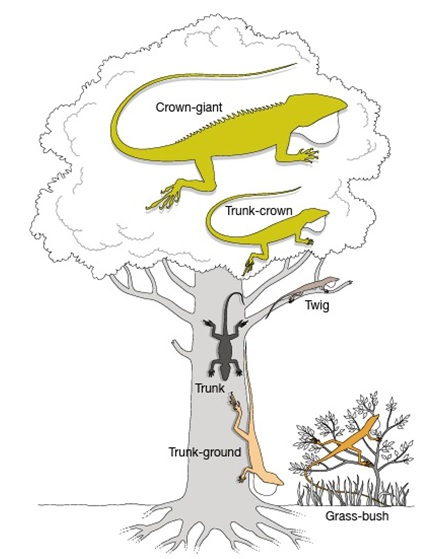
JL: I would predict that the species would first become very abundant and would utilize a broad range of habitats and resources. Then, if for some reason the species split into two species (perhaps populations become isolated on different sides of a river), and if those species then came into contact, individuals of the two species would diverge in resource use (the food they ate, the habitat they used) to minimize interactions between the species. Then, each species would evolve adaptations for the restricted set of resources and habitats they were using. If this process happened multiple times, you would end up with a set of species adapted to use different parts of the environment—an adaptive radiation!
RRD: And would you get the classic set of anolis morphs? The canopy anole, the twig-dwelling anole, the trunk anole and so on?
JL: I think it would depend on the size of the island. There’s a curious relationship between island size and evolutionary diversification in anoles. Only on very large islands, the size of Jamaica or larger, does speciation occur, one ancestral species giving rise to two descendant species.
RRD: So in the Caribbean, that means Jamaica, Cuba, Hispaniola and Puerto Rico (the four biggest islands in the map below).
JL: It would have to be on one of those large islands. But if it were, I would predict that the usual suite of anole ecomorphs would evolve. Of course, I’m assuming those islands were similar to the islands in the Caribbean where anoles evolve. We have no idea what would happen if the islands were very different, say, like the Galápagos. In that case, I’m not sure how anoles would evolve.

RRD: What if the lizards that arrived were not Anolis lizards but instead some other lineage, would the predictions still hold?
JL: My guess is no.
RRD: Oh, that surprises me.
JL: People have looked for evidence that other types of lizards elsewhere in the world have diversified in the same replicated pattern as anoles, but there aren’t any other good examples. We don’t know why this is. Is it something special about anoles that predisposes them to diversify in the same way time after time? Or is it the islands? Are the islands of the Greater Antilles so similar to each other that they have exactly the same opportunities, and so the lizards adapt to them in the same way? Or maybe it’s both: the right type of lizard on the right type of islands.
RRD: Do you find the lizards themselves more beautiful or do you find the knowable features of natural selection and evolution more beautiful? Or if beauty isn’t the right word, choose another one.
JL: Well, some of these lizards are truly gorgeous. But the replicated evolutionary outcomes on each island are a beautiful example of the power of natural selection to guide evolution. So I call it a toss-up!
RRD: In your own life, if we replayed the tape, and started you off studying some other group of organisms, do you think you would have still ended up interested and studying aspects of convergence? Was anything about your work somehow inevitable? If you hadn’t come to understand the anoles, would someone else have?
JL: Second question first: if I hadn’t picked up on this, someone else certainly would have. Ernest Williams, the Grand Old Man of Anolis, laid the groundwork and I was in the right place at the right time. With the development of phylogenetic comparative methods and the increased interest in convergence, it would only have been a matter of time.
RRD: I think you may be selling your own unique insights short, but I take the point.
JL: As for myself, I’m a firm believer in historical contingency. There are so many fascinating topics in evolutionary biology, so it’s easy to see that I could have gotten interested in other topics. Initially, I went to grad school thinking I would study behavioral ecology. What if my first research project on monitor lizards hadn’t crashed and burned, or the second on collared lizards (both failing because I did field projects in bad years in which populations were low and thus hard to study)? What if I had learned about beetle diversity earlier? No, there was nothing predestined about my interest in convergence.
RRD: Someday humans will go extinct. When we do, evolution will proceed without our thumb on the scale. I would like your thoughts about two different scenarios. In one, major lineages of, for example, mammals are still around. There are still cats, of some kind. There are still canids. There is still, somewhere, a small population of elephants. In that case, is there anything you think you could predict about who might evolve?
JL: Well, if it’s just us that disappears, I’d think that some other primate eventually might give rise to something like us. Maybe the savannah-inhabiting chimps of West Africa (Figure 3)? But more generally, I wonder if rats and cockroaches and pigeons, so abundant now, might have the leg up to begin diversifying once we were gone.
RRD: Would you expect forms like canids and felids to evolve anew if canids and felids went extinct?
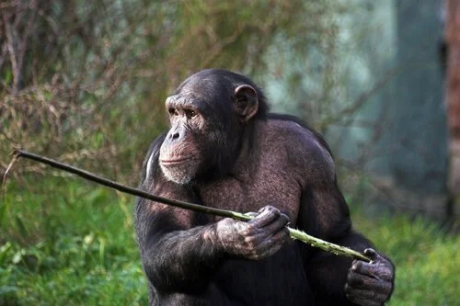
JL: If there were still canids and felids around, I wouldn’t expect other types of animals to evolve into a similar form, at least not in their presence. But if they weren’t around, it’s possible that some other type of animal would evolve in that way. Look at Australia, where felines and canids are not native. Marsupials produced the thylacine, which from a distance you might mistake for a cool new breed of dog, and some other, now extinct, predators that were somewhat similar to leopards or lions. So, it’s certainly possible that canid- or felid-like predators could evolve again in your scenario.
RRD: Now, what about a scenario in which cats and dogs are gone. Evolution is starting anew with rodents? Or if you don’t like my mammalian focus here, maybe there is a lizard or fish version of my question you can answer.
JL: The more distant you get from us, evolutionarily, the less likely it is that a lineage would evolve to be very similar to us. That is, let’s suppose that somehow the rat lineage goes wild and gets larger and more intelligent, even eventually evolving levels of intelligence comparable to ours. Would they be bipedal, round-headed, tailless rodents that basically were humanesque? I doubt it.
RRD: But we still see big predators evolving again? And tree-dwelling species with big eyes for finding fruits? And fast-running, long-legged herbivores? Or not necessarily?
JL: Anything’s possible, and nothing’s guaranteed. It seems very likely that predators of some sort would evolve. Other species are a great resource waiting to be utilized. But would those predators look anything like those with which we’re familiar? That’s the question. Given that marsupials can produce a dog-like animal, I don’t see why rodents couldn’t, though that doesn’t mean it necessarily would happen. As for a fish…well, there’s a long stretch of evolution required to produce something like a dog. But, of course, if you go back far enough in dog ancestry, you’ll find a fish, so why not again?
RRD: Do you think that there are groups of organisms that are more likely to show convergence than are others? Are anoles somehow special? Insects show a lot of convergence, but it is also hard to say proportionally how common it is because they are so diverse. It almost feels like we know that convergence is relatively common but we still lack a big picture approach for making sense of what that commoness means. How do you think about all of this?
JL: In the bigger picture, you’ve hit on the key question in assessing the extent of convergence: we know that a lot of it has occurred, but we don’t know the denominator—how many times has there been the opportunity for convergence, but it has failed to evolve?
And your first question is also apt: we really don’t know if there is something intrinsic to anoles (or other organisms that show a lot of convergence) that makes them more likely to converge than other types of organisms. What would such a thing be? There are ideas about the structure of the genome (sometimes called the “genetic architecture”) that constrains or channels evolution to most easily happen in certain directions. So, if a lineage has such a genetic architecture, then species in that lineage might be more likely to evolve in the same way in response to natural selection, whereas species in a lineage with a less constraining—more open—genetic architecture might be more likely to evolve in many different ways, even in response to the same natural selection pressures.
RRD: Right, so some species might just have genes and traits that make it easy for them to rapidly evolve new forms in new environments.
JL: Of course, the other side of the coin is that it may be the environment that drives convergence. Lineages occurring in very similar environments might be more likely to converge than lineages living in more different environments.
RRD: I’ve often thought that extreme environments, such as deserts, tend to favor convergence, that maybe in very very hot places, very dry places and extremely wet places, there are fewer ways to survive.
JL: We do know one thing, though: the more closely related two species are (at the extreme, two populations of the same species), the more likely they are to evolve in the same way. That is both because they share similarities in their genetic architecture (and sometimes in the actual alleles, the versions of genes, they possess), and because they are overall more similar, and thus the most beneficial adaptive response to a given situation is likely to be similar.
RRD: So in this way the anoles might have the right genes and traits to allow convergence, but that the anoles arriving on different islands were related (at some level) also meant that they had a similar potential to evolve convergently in a particular way.
RRD: What do you think the greatest applied insights from studying evolution’s predictability to date have been? I found your consideration of this question in your book to be particularly compelling.
JL: I’ll be honest and say that I was surprised that there weren’t more applied applications of evolutionary predictability. Apparently, it’s still early days in this regard. But clearly the most important are in the biomedical realm, in terms of understanding the evolution of antibiotic resistance and how we can thwart it. To the extent that microbes evolve the same adaptations to thwart our drugs—which they do in some cases, but not others—we will be better poised to design new antibiotics to counter them. This is an area of active research.The key question is: in which situations will microbes evolve convergently, and in which situations will they find different solutions? If we can understand that, we’ll be poised to make a major advance in countering antibiotic resistance.
RRD: What do you think the answer to that question will be in ten years?
JL: Probably the same, but extending to related questions, like the evolution of pesticide resistance.
RRD: But your feeling is that we’ve kind of failed (so far) to take advantage of insights from convergent evolution? Is part of the issue the divide between medical research and evolutionary biology? Do we need to trap clinicians and evolutionary biologists in a (socially distanced) room and charge them with working out some solutions to some of the big problems?
JL: We’ve already seen that evolutionary thinking has a lot to offer to medical science. There have been some really clever research into the evolution of human pathogens that looked for examples of convergent evolution as a means of identifying adaptive change. More evolution-inspired work would no doubt be very productive.
RRD: I was struck by the example of work on Pseudomonas bacteria in cystic fibrosis patients, where the bacteria repeatedly evolve similar mutations in the lungs of different patients. The lungs were like islands and the bacteria were like anoles, but with horrible consequences.
RRD: In considering life on other planets, or life after humans on this planet, it seems like people often come back to the question of whether that life evolves intelligence (you cover this some in your book). Do you think there is a better question to ask about evolution after us or evolution on other planets. Imagine we find four other planets with life, what would you want to study on them?

JL: Given that it took so long for our level of intelligence to evolve on this planet, I think we have to conclude that it is not something that evolves readily. So I wouldn’t be at all sure that if we find life on another planet, it would be intelligent life. So what I would want to study is simply how similar the life forms were among the planets—how much convergence over all has occurred? And to the extent that the life forms were very different, how much of that could be attributed to environmental differences on the planets, and how much to the way life had evolved (e.g., what kind of inheritance system they had, whether life is carbon-based).
RRD: It would be disappointing if the rules we have figured out about life on Earth only apply to life on Earth. And yet, even if I knew that were the case, I’d still go on studying them, wouldn’t you? I’m reminded of a poem by Hayden Carruth. He wrote…
The Last Poem in the World
Would I write it if I could?
You bet your glitzy ass I would.
RRD: What is the one thing (or several things) that you think people need to understand about evolution. It could be something important to going about our lives, but it could also be something that you think is powerful. What do you wish people knew?
JL: Evolution has no foresight. It occurs in response to the current conditions, making use of whatever genetic variation is present in a population. For that reason, the outcome is not always outcome—sometimes natural selection does the best it can. In this way, one famous scientist said that natural selection is a tinkerer, not an engineer.
And, finally, natural selection and evolution are not the same thing. Natural selection is a mechanism—probably the most important one—that can cause evolution, but there are others. Evolution can occur without natural selection. And, conversely, natural selection can occur without producing evolution. That can happen because natural selection favors individuals with one trait over individuals with another. But if those traits are not the result of genetic differences, then the trait won’t be passed to the next generation. Consider body builders. They have big muscles. If natural selection favored humans with big muscles, they would survive and others would perish. But individuals in the next generation wouldn’t necessarily have bigger muscles (unless they all decided to become weight lifters). On the other hand, if natural selection favored individuals with a trait that is a result of a genetic difference—say, eye color—then that trait would be transmitted to the next generation. Selection for blue eyes would lead to more people with blue eyes in the next generation.
RRD: If you ever retire, will you continue doing research after you retire? If so, what would you study?
JL: Well, I’m not considering retiring any time soon! But if and when I do, who knows? I enjoy writing, so maybe I’ll do more of that. And I’ve become interested in the variation in cats and what it tells us about the evolutionary process. Maybe I’ll study them. Or just pet them.







